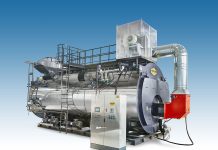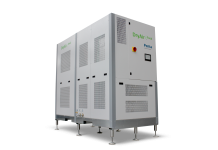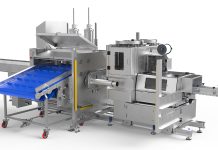Vacuum cooling
For cooked foods, as bakery products, the product has to cool down completely before packaging. If this condition is not observed, the water vapour condensing inside the package can cause the moulding of the product, or the migration to the product of substances present in the packaging material (often not suitable for contact with warm foods). Waiting for the product to cool down completely, however, is a “dead time” for many food processors, and creates practical logistics problems, as occupation of space for many hours, extension of production cycles, and, in the last resort, economic losses. For this reason the cooling process is often accelerated by running the product through a cooling tunnel. Rapid cooling of freshly baked products involves high energy consumption, not to mention that a cool environment may have negative effects on certain products, especially baked goods, accelerating their staling process. These limitations can be overcome by using vacuum cooling. Vacuum technology has been known and applied for decades in the food industry. The physical principle is similar to that of dry-freezing, whereby moist products containing free water are cooled by evaporation of moisture under vacuum: the latent heat removed when moisture evaporates from the product allows for uniform cooling of the product. Water evaporation temperature, in fact, is not fixed, but depends from the atmospheric pressure: the lower the of pressure (increasing the vacuum gradually), the lower will be the temperature at which starts the evaporation of moisture. An air suction system keeps the pressure at the pre-set vacuum level. The cooling effect is rapid and uniform all over the product. Vacuum cooling is far quicker than conventional/ conduction cooling in ambient air or refrigerated environment, and is mainly used in the bakery sector. The reduction in cooling times is more obvious with larger products: from several hours to a few minutes. Quick cooling provides that temperature ranges (from approx. 60° to 20 °C), at which microbial spores can germinate, are very short: a very important issue for stuffed baked goods.
The effectiveness of vacuum cooling technology, and the time taken to end the process, do not depend from the quantity of processed product (the opposite of what occurs in cooling cells or tunnels). Finally, very rapid cooling results in significant financial and energy savings for the companies that apply this technology. One of the possible problems of vacuum cooling is higher weight loss of the product compared to conventional systems. During the vacuum cooling process, in fact, part of the free water contained in the product is converted into water vapour inside the piece of bread (which is not the case with room temperature or refrigerated cooling): this can explain the slightly higher loss of weight. A lower moisture rate inside the product, however, may improve the product quality and increase its shelf life. Moreover, the vacuum cooling technology provides for a more uniform moisture distribution inside the product, thus making bakery products less crusty on the outside and less spongy inside. The major advantage of vacuum cooling over other techniques of cooling is the short time required to cool a suitable product to a given temperature. Conventional forms of cooling (such as cold storage and cooling tunnel) exploit the heat transferred from the product to the surrounding air by convection of by conduction. These processes are known to be slow, especially if there is no forced-air; furthermore, they are slowed down by the lower heat Δ difference between food and air. Furthermore, they are less effective in case of low surface to volume ratio, especially for large products (difficulty to cool to the centre of the product). An important parameter to be taken into account is the energy consumption of this equipment, considering the long processing time for reducing the temperature to acceptable levels, and the floor space required for cooling in tunnels or storage rooms. Vacuum cooling provides additional advantages, especially in the case of bakery products, including extension of crust life, improved volume and softness: In fact, these products offer improved texture, shape, and moisture distribution with less collapse and contraction, increased shelf life. Next to making the cooling process more rapid, especially for products like bread, vacuum can be effectively used to improve the texture and volume of bakery products. Since the entire product is exposed to the cooling action, it is certain that even the centre of the product is cold, or better is cooler than its outside (very important issue for stuffed products). The product shape stabilisation is obtained thanks to the pressure reduction, thus eliminating the loss of volume (ca. 10%) which is typical for convection cooled products. Process parameters are constant and reproducible, and the end result is independent from external environmental conditions (temperature, humidity, etc.); furthermore, there is the short time required to cool, with obvious advantages in terms of organization, economy and hygiene: with conventional forms of cooling such as air blast, water immersion and cold storage, in fact, the product must be kept in environments that are exposed to contamination risks and/or that may favour the development of moulds or other micro-organisms. Vacuum cooling may be advantageously used even for products like pizza, puff pastry, traditional celebration cakes, and pastry products.
Literature
1. L. Garcia-Gonzales et al., 2007. High pressure carbon dioxide inactivation of microorganisms in food. International Journal of Food Microbiology, 117:1-28
by Flavio Gibilras




